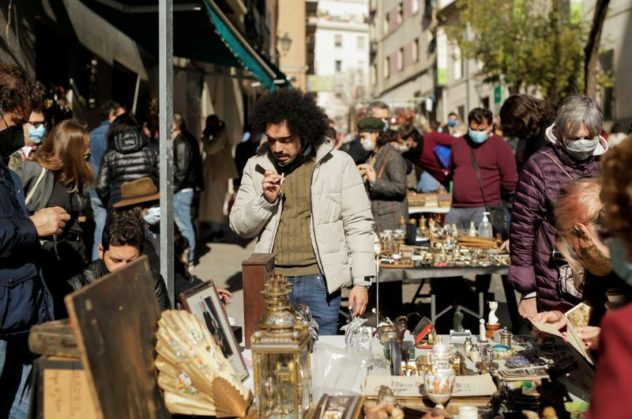©Reuters
Pre-reading questions:
I will read each question. Then, please answer them.
- Where do you usually buy cheap things?
- How often do you go shopping at open-space markets?
Vocabulary:
I will read the words, meanings, and sample sentences. Then, repeat after me.
- security /si-KYOOR-i-tee/
- throughout /throo-OUT/
- stall /stawl/
- purchasing /PUR-chuhs-ing/
- secondhand /SEK-uhnd-HAND/
[noun] – protection of a person, building, organization, or country against threats such as crime or attacks by foreign countries
The building tightened its security after the robbery incident.
[preposition] – in every part, or during the whole period of time
James looked throughout the house, but still couldn’t find his wallet.
[noun] – a large table or a small shop with an open front from which goods are sold in a public place
His family owns a fruit and vegetable stall in the market.
[noun] – the activity of buying goods and services
Purchasing stamps and cards is one of my many hobbies.
[adjective] – owned or used in the past by someone else
Do you have any secondhand books to sell?
Article reading:
Please read the whole article. Then, I will check your pronunciation and intonation.
El Rastro, Madrid’s most famous street market, reopened on Sunday, November 22, after more than 8 months of closure due to the pandemic. Only 2,000 visitors at a time are allowed to enter the entire marketplace and security is tightened throughout the area. Entrances and exits are under strict lookout by police officers to make sure that people will follow only one route in and out the market. There are also less stalls that are placed far apart from each other to apply social distancing rules. El Rastro, one of Spain’s largest marketplaces, is open on Sundays and public holidays.
El Rastro is noted to be established in 1740 in a historic area in Madrid, making it a popular destination for foreigners and locals alike. The market was originally a meeting place for traders and purchasing of secondhand clothes. Now, stalls in the market sell a wide range of items from shirts to antiques. Streets near El Rastro like Calle de San Cayetano and Calle de Rodas are popular for the items they are offering, namely paintings, art tools, and trading of magazines, stickers, and cards.
El Rastro is noted to be established in 1740 in a historic area in Madrid, making it a popular destination for foreigners and locals alike. The market was originally a meeting place for traders and purchasing of secondhand clothes. Now, stalls in the market sell a wide range of items from shirts to antiques. Streets near El Rastro like Calle de San Cayetano and Calle de Rodas are popular for the items they are offering, namely paintings, art tools, and trading of magazines, stickers, and cards.
Comprehension Questions:
I will read each question. Then, please answer them based on the article.
- When was El Rastro noted to be established?
- How many visitors are allowed in the market at a time?
- What do the stalls in El Rastro sell nowadays?
- When is El Rastro open?
- El Rastro reopens after how many months of closure?
Discussion Questions:
I will read each question. Then, please answer them.
- How safe do you think it is in El Rastro during this time of the pandemic?
- If you were in Madrid, what would you buy in El Rastro? Why?
- If given the chance, will you visit El Rastro? Why or why not?
- What are the advantages and disadvantages of open-space marketplaces?
- Do you prefer to go shopping in malls or at flea markets? Kindly explain why.
